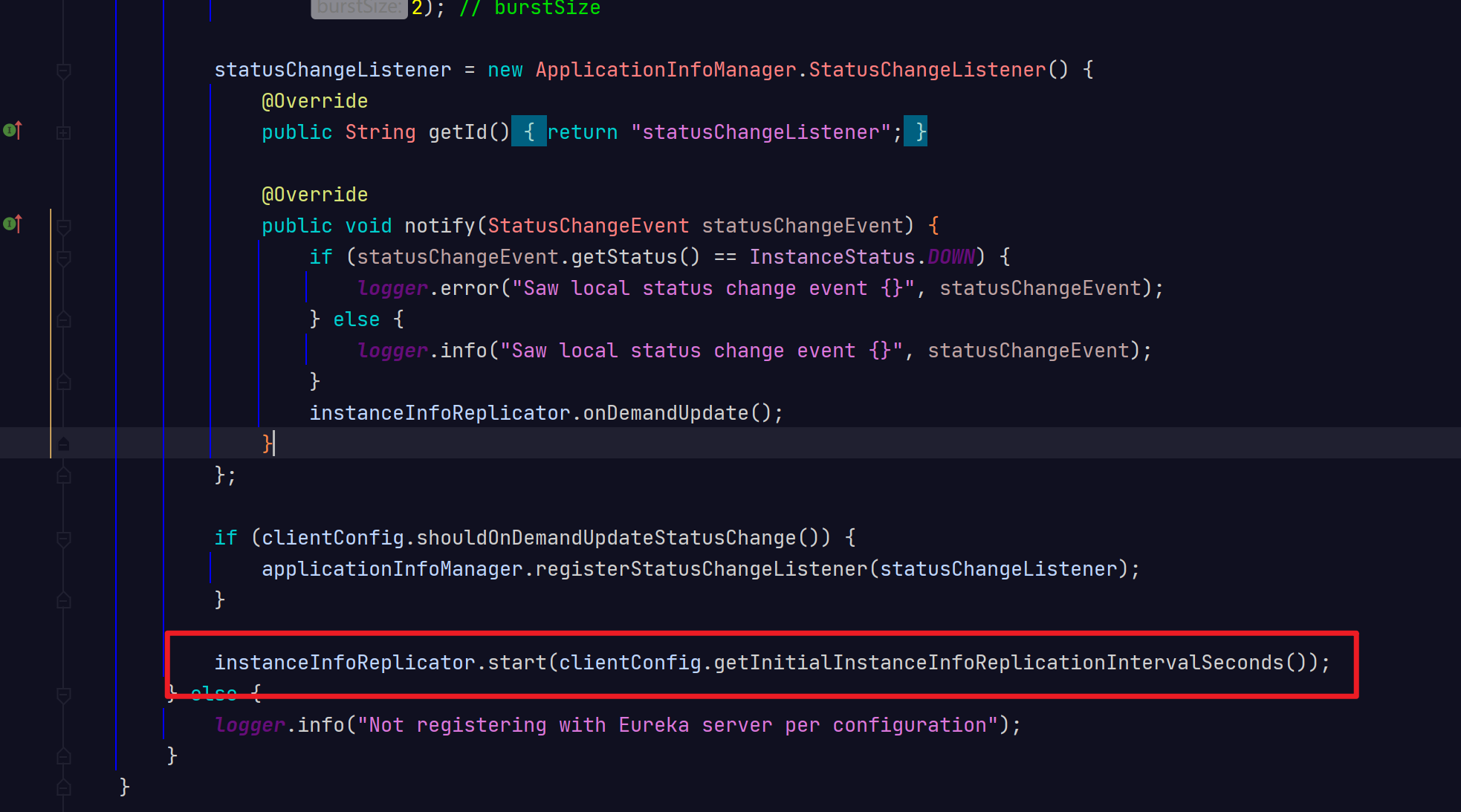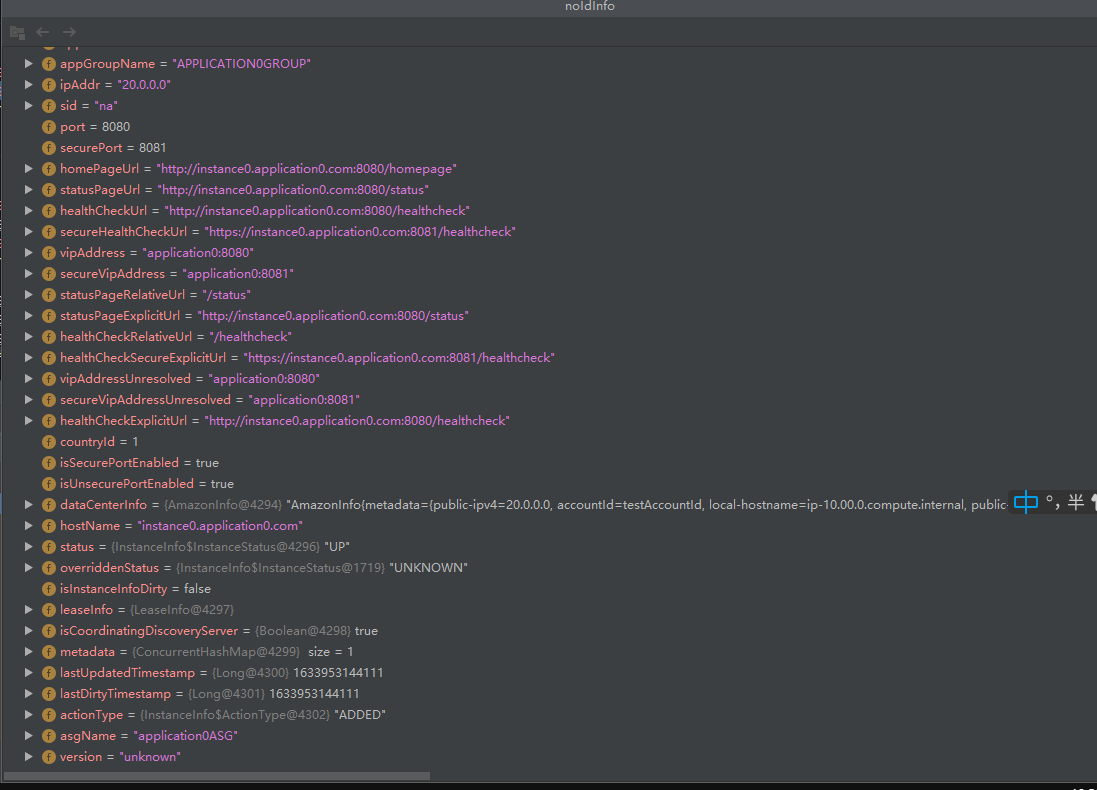eureka的注册
eureka client的注册
Eureka-Client 向 Eureka-Server 发起注册应用实例需要符合如下条件:
- 配置
eureka.registration.enabled = true,Eureka-Client 向 Eureka-Server 发起注册应用实例的开关。 - InstanceInfo 在 Eureka-Client 和 Eureka-Server 数据不一致。
每次 InstanceInfo 发生属性变化时,标记 isInstanceInfoDirty 属性为 true,表示 InstanceInfo 在 Eureka-Client 和 Eureka-Server 数据不一致,需要注册。另外,InstanceInfo 刚被创建时,在 Eureka-Server 不存在,也会被注册。
当符合条件时,InstanceInfo 不会立即向 Eureka-Server 注册,而是后台线程定时注册。
当 InstanceInfo 的状态( status ) 属性发生变化时,并且配置 eureka.shouldOnDemandUpdateStatusChange = true 时,立即向 Eureka-Server 注册。因为状态属性非常重要,一般情况下建议开启,当然默认情况也是开启的。
eureka-client的代码非常怪,因为注册逻辑在InstanceInfoReplicator组件里面,服务实例信息复制组件,就是这么一个复制组件,来负责服务的注册,replicate一般理解为复制,但是它却来做注册的功能,所以第一次看代码会找不到入口。
DiscoveryClient#initScheduledTasks

传进去的参数为40s,会把isInstanceInfoDirty设置为true,然后把当前时间戳设置成lastDirtyTimestamp
public void start(int initialDelayMs) {
if (started.compareAndSet(false, true)) {
instanceInfo.setIsDirty();
//把自己当成一个线程,默认是40秒去执行这个线程
Future next = scheduler.schedule(this, initialDelayMs, TimeUnit.SECONDS);
scheduledPeriodicRef.set(next);
}
}
/**
* Sets the dirty flag so that the instance information can be carried to
* the discovery server on the next heartbeat.
*/
public synchronized void setIsDirty() {
isInstanceInfoDirty = true;
lastDirtyTimestamp = System.currentTimeMillis();
}
定时检查 InstanceInfo 的状态( status ) 属性是否发生变化。若是,发起注册。实现代码如下:
public void run() {
try {
//刷新了服务实例的信息
discoveryClient.refreshInstanceInfo();
//由于前面setIsDirty中把isInstanceInfoDirty设置了true,此处就会返回时间戳,因此会发生注册
Long dirtyTimestamp = instanceInfo.isDirtyWithTime();
if (dirtyTimestamp != null) {
discoveryClient.register();
instanceInfo.unsetIsDirty(dirtyTimestamp);
}
} catch (Throwable t) {
logger.warn("There was a problem with the instance info replicator", t);
} finally {
Future next = scheduler.schedule(this, replicationIntervalSeconds, TimeUnit.SECONDS);
scheduledPeriodicRef.set(next);
}
}
服务刷新暂时先不关注,直接去看注册的代码,服务注册的时候,是基于EurekaClient的reigster()方法去注册的,调用的是底层的TransportClient的RegistrationClient,执行了register()方法,将InstanceInfo服务实例的信息,通过http请求,调用eureka server对外暴露的一个restful接口,将InstanceInfo给发送了过去。这里找的是EurekaTransport,在构造的时候,调用了scheduleServerEndpointTask()方法,这个方法里就初始化了专门用于注册的RegistrationClient。
/**
* Register with the eureka service by making the appropriate REST call.
*/
boolean register() throws Throwable {
logger.info(PREFIX + "{}: registering service...", appPathIdentifier);
EurekaHttpResponse<Void> httpResponse;
try {
httpResponse = eurekaTransport.registrationClient.register(instanceInfo);
} catch (Exception e) {
logger.warn(PREFIX + "{} - registration failed {}", appPathIdentifier, e.getMessage(), e);
throw e;
}
if (logger.isInfoEnabled()) {
logger.info(PREFIX + "{} - registration status: {}", appPathIdentifier, httpResponse.getStatusCode());
}
return httpResponse.getStatusCode() == Status.NO_CONTENT.getStatusCode();
}
真正执行注册请求的,就是eureka-client-jersey2工程里的AbstractJersey2EurekaHttpClient,请求http://localhost:8080/v2/apps/ServiceA,将服务实例的信息发送过去
@Override
public EurekaHttpResponse<Void> register(InstanceInfo info) {
String urlPath = "apps/" + info.getAppName();
Response response = null;
try {
Builder resourceBuilder = jerseyClient.target(serviceUrl).path(urlPath).request();
addExtraProperties(resourceBuilder);
addExtraHeaders(resourceBuilder);
response = resourceBuilder
.accept(MediaType.APPLICATION_JSON)
.acceptEncoding("gzip")
.post(Entity.json(info));
return anEurekaHttpResponse(response.getStatus()).headers(headersOf(response)).build();
} finally {
if (logger.isDebugEnabled()) {
logger.debug("Jersey2 HTTP POST {}/{} with instance {}; statusCode={}", serviceUrl, urlPath, info.getId(),
response == null ? "N/A" : response.getStatus());
}
if (response != null) {
response.close();
}
}
}
com.netflix.eureka.resources.ApplicationResource,处理单个应用的请求操作的 Resource ( Controller )。注册应用实例信息的请求,映射 ApplicationResource#addInstance() 方法,实现代码如下:
@POST
@Consumes({"application/json", "application/xml"})
public Response addInstance(InstanceInfo info,
@HeaderParam(PeerEurekaNode.HEADER_REPLICATION) String isReplication) {
logger.debug("Registering instance {} (replication={})", info.getId(), isReplication);
// validate that the instanceinfo contains all the necessary required fields
if (isBlank(info.getId())) {
return Response.status(400).entity("Missing instanceId").build();
} else if (isBlank(info.getHostName())) {
return Response.status(400).entity("Missing hostname").build();
} else if (isBlank(info.getIPAddr())) {
return Response.status(400).entity("Missing ip address").build();
} else if (isBlank(info.getAppName())) {
return Response.status(400).entity("Missing appName").build();
} else if (!appName.equals(info.getAppName())) {
return Response.status(400).entity("Mismatched appName, expecting " + appName + " but was " + info.getAppName()).build();
} else if (info.getDataCenterInfo() == null) {
return Response.status(400).entity("Missing dataCenterInfo").build();
} else if (info.getDataCenterInfo().getName() == null) {
return Response.status(400).entity("Missing dataCenterInfo Name").build();
}
// handle cases where clients may be registering with bad DataCenterInfo with missing data
DataCenterInfo dataCenterInfo = info.getDataCenterInfo();
if (dataCenterInfo instanceof UniqueIdentifier) {
String dataCenterInfoId = ((UniqueIdentifier) dataCenterInfo).getId();
if (isBlank(dataCenterInfoId)) {
boolean experimental = "true".equalsIgnoreCase(serverConfig.getExperimental("registration.validation.dataCenterInfoId"));
if (experimental) {
String entity = "DataCenterInfo of type " + dataCenterInfo.getClass() + " must contain a valid id";
return Response.status(400).entity(entity).build();
} else if (dataCenterInfo instanceof AmazonInfo) {
AmazonInfo amazonInfo = (AmazonInfo) dataCenterInfo;
String effectiveId = amazonInfo.get(AmazonInfo.MetaDataKey.instanceId);
if (effectiveId == null) {
amazonInfo.getMetadata().put(AmazonInfo.MetaDataKey.instanceId.getName(), info.getId());
}
} else {
logger.warn("Registering DataCenterInfo of type {} without an appropriate id", dataCenterInfo.getClass());
}
}
}
registry.register(info, "true".equals(isReplication));
return Response.status(204).build(); // 204 to be backwards compatible
}
调用 PeerAwareInstanceRegistryImpl#register(...) 方法,注册应用实例信息。实现代码如下:
public void register(InstanceInfo registrant, int leaseDuration, boolean isReplication) {
read.lock();
try {
Map<String, Lease<InstanceInfo>> gMap = registry.get(registrant.getAppName());
// 增加 注册次数 到 监控
REGISTER.increment(isReplication);
//如果某个服务第一次来注册,那gMap是获取不到的
//这个时候就会注册一个新的gNewMap,赋值给gMap
//gmap就是注册一个注册表,包含了所有实例的信息
if (gMap == null) {
final ConcurrentHashMap<String, Lease<InstanceInfo>> gNewMap = new ConcurrentHashMap<String, Lease<InstanceInfo>>();
gMap = registry.putIfAbsent(registrant.getAppName(), gNewMap);
if (gMap == null) {
gMap = gNewMap;
}
}
//感觉InstanceID,获取到实例
Lease<InstanceInfo> existingLease = gMap.get(registrant.getId());
// Retain the last dirty timestamp without overwriting it, if there is already a lease
if (existingLease != null && (existingLease.getHolder() != null)) {
Long existingLastDirtyTimestamp = existingLease.getHolder().getLastDirtyTimestamp();
Long registrationLastDirtyTimestamp = registrant.getLastDirtyTimestamp();
logger.debug("Existing lease found (existing={}, provided={}", existingLastDirtyTimestamp, registrationLastDirtyTimestamp);
// this is a > instead of a >= because if the timestamps are equal, we still take the remote transmitted
// InstanceInfo instead of the server local copy.
if (existingLastDirtyTimestamp > registrationLastDirtyTimestamp) {
logger.warn("There is an existing lease and the existing lease's dirty timestamp {} is greater" +
" than the one that is being registered {}", existingLastDirtyTimestamp, registrationLastDirtyTimestamp);
logger.warn("Using the existing instanceInfo instead of the new instanceInfo as the registrant");
registrant = existingLease.getHolder();
}
} else {
// 如果这个实例第一次进来的话,就走这个判断
synchronized (lock) {
if (this.expectedNumberOfClientsSendingRenews > 0) {
// Since the client wants to register it, increase the number of clients sending renews
//看注释,当客户端进行注册的时候,会新增一共个,期望客户端数量的值
this.expectedNumberOfClientsSendingRenews = this.expectedNumberOfClientsSendingRenews + 1;
updateRenewsPerMinThreshold();
}
}
logger.debug("No previous lease information found; it is new registration");
}
//会将InstanceInfo对象封装成一个Lease对象
Lease<InstanceInfo> lease = new Lease<InstanceInfo>(registrant, leaseDuration);
if (existingLease != null) {
lease.setServiceUpTimestamp(existingLease.getServiceUpTimestamp());
}
//讲上面封装的Lease对象放到gMap中,key就是服务实例Id
gMap.put(registrant.getId(), lease);
recentRegisteredQueue.add(new Pair<Long, String>(
System.currentTimeMillis(),
registrant.getAppName() + "(" + registrant.getId() + ")"));
// This is where the initial state transfer of overridden status happens
if (!InstanceStatus.UNKNOWN.equals(registrant.getOverriddenStatus())) {
logger.debug("Found overridden status {} for instance {}. Checking to see if needs to be add to the "
+ "overrides", registrant.getOverriddenStatus(), registrant.getId());
if (!overriddenInstanceStatusMap.containsKey(registrant.getId())) {
logger.info("Not found overridden id {} and hence adding it", registrant.getId());
overriddenInstanceStatusMap.put(registrant.getId(), registrant.getOverriddenStatus());
}
}
InstanceStatus overriddenStatusFromMap = overriddenInstanceStatusMap.get(registrant.getId());
if (overriddenStatusFromMap != null) {
logger.info("Storing overridden status {} from map", overriddenStatusFromMap);
registrant.setOverriddenStatus(overriddenStatusFromMap);
}
// Set the status based on the overridden status rules
InstanceStatus overriddenInstanceStatus = getOverriddenInstanceStatus(registrant, existingLease, isReplication);
registrant.setStatusWithoutDirty(overriddenInstanceStatus);
// If the lease is registered with UP status, set lease service up timestamp
if (InstanceStatus.UP.equals(registrant.getStatus())) {
lease.serviceUp();
}
registrant.setActionType(ActionType.ADDED);
// 添加到 最近租约变更记录队列
recentlyChangedQueue.add(new RecentlyChangedItem(lease));
// 设置 租约的最后更新时间戳
registrant.setLastUpdatedTimestamp();
//清空缓存
invalidateCache(registrant.getAppName(), registrant.getVIPAddress(), registrant.getSecureVipAddress());
logger.info("Registered instance {}/{} with status {} (replication={})",
registrant.getAppName(), registrant.getId(), registrant.getStatus(), isReplication);
} finally {
read.unlock();
}
}
public class Lease<T> {
/**
* 实体
*/
private T holder;
/**
* 注册时间戳
*/
private long registrationTimestamp;
/**
* 开始服务时间戳
*/
private long serviceUpTimestamp;
/**
* 取消注册时间戳
*/
private long evictionTimestamp;
/**
* 最后更新时间戳
*/
// Make it volatile so that the expiration task would see this quicker
private volatile long lastUpdateTimestamp;
/**
* 租约持续时长,单位:毫秒
*/
private long duration;
public Lease(T r, int durationInSecs) {
holder = r;
registrationTimestamp = System.currentTimeMillis();
lastUpdateTimestamp = registrationTimestamp;
duration = (durationInSecs * 1000);
}
}
holder属性,租约的持有者。在 Eureka-Server 里,暂时只有 InstanceInfo 使用。registrationTimestamp属性,注册( 创建 )租约时间戳。在构造方法里可以看租约对象的创建时间戳即为注册租约时间戳。serviceUpTimestamp属性,开始服务时间戳。lastUpdatedTimestamp属性,最后更新租约时间戳。每次续租时,更新该时间戳。注册应用实例信息会使用到它如下方法,实现代码如下:duration属性,租约持续时间,单位:毫秒。当租约过久未续租,即当前时间 -lastUpdatedTimestamp>duration时,租约过期。evictionTimestamp属性,租约过期时间戳。
下面对InstanceInfo的具体信息

下图为注册表的信息


